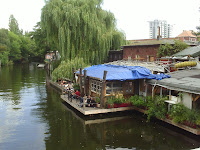 |
| The famous Yorchlӧsschen |
Yorchschlӧsschen
Address: Yorckstraβe 15, 10965, Kreuzberg
U-Bahn: Yorckstraβe
Opening times: 9pm-late
Admission: 4€ - 6€
Website: yorckschloesschen.de
B Flat
Address: Rosenthaler Straße 13, 10119, Mitte
U-Bahn: Weinmeisterstraße
Opening times: Mon - Sun 9pm - 2am
Admission: 5€ - 15€, Wed-free
Website: www.b-flat-berlin.de
A-Trane
Address: Pestalozzistraβe 105, 10625, Charlottenburg
U-Bahn: Savignyplatz
Opening times: Mon -Thur 9pm-2pm, Fri-Sat 9pm-late
Admission: 5€ - 20€, Mon-free
Website: a-trane.de
It seems like Berlin bops to a swing beat as the city is
full of jazz venues providing quality live music all week long. But where is
the best place for jazzsters to go when it is summertime and the living is
easy?
In Mitte, along the busy Rosenthaler
Straβe,
you will find the comically named B Flat. This popular live music venue has
bands playing to eager crowds most nights. Everything revolves around the music
here, with minimalist decor and an intimate stage situated close to the
audience. The high ceiling provides excellent acoustics, making the bass line
shake your table and keep your toes tapping. You won’t find any cigar smoking,
sharp-suited hipsters here either, just music enthusiast socialising over
cocktails. The entry prices may vary and drinks are expensive at 3.50€ for a
beer, however on Wednesday it is free entry to the mid-week jam sessions. Don’t
worry, this doesn’t mean you have to endure excruciating sets from tuneless
amateurs. These sessions attract the best local talent. Arrive early as the
place soon fills up.
If you prefer a more
traditional dimly lit, steamy jazz bar, however, then you can find no better
than The Yorckschlӧsschen on the corner of Yorchstraβe in
Kreuzberg. The club has existed for over 100 years and has been the cornerstone
of the area’s jazz scene. The venue is instantly recognisable from the large,
curved sign above the entrance which reminds you of a 50’s cinema. On weekends
local music lovers pack themselves between the walls cluttered with vintage posters
and memorabilia. Antique chandeliers cast light upon the crowd as local bands
play anything from jazz and soul to Mississippi blues. You don’t have to break
the bank here as a beer costs 2.50€ and entry normally around 4€ to 6€
depending on the night. There is even has a beautiful beer garden where
you can enjoy a drink and a cigarette while the music filters out into the
evening air.
For a more sophisticated jazz experience head towards ritzy
Charlottenburg and the A-Trane jazz bar. Put out your smart shirt, order
yourself a cocktail and grad one of the red, candlelit tables that are squeezed
into the intimate venue. Yes the prices are more expensive (4.50€ for a
large beer and 8€ for a cocktail) but the talent on display is of the
highest category. Jazz heroes, like Oscar and Grammy award winning pianist Herbie
Hancock and legendary drummer Billy Cobham, have all walked through its doors.
Signed black and white portraits of jazz greats hang upon the walls. As you can
imagine for gigs like this the entry fee will be pricey. However the open jam
night run by pianist Andreas Schmidt on Monday nights is free and offers virtuoso
and spontaneous performances from local musicians. For an extra treat before
the show head to nearby Savignyplatz for dinner at the elegant Zwӧlf
Apostles pizzeria.










